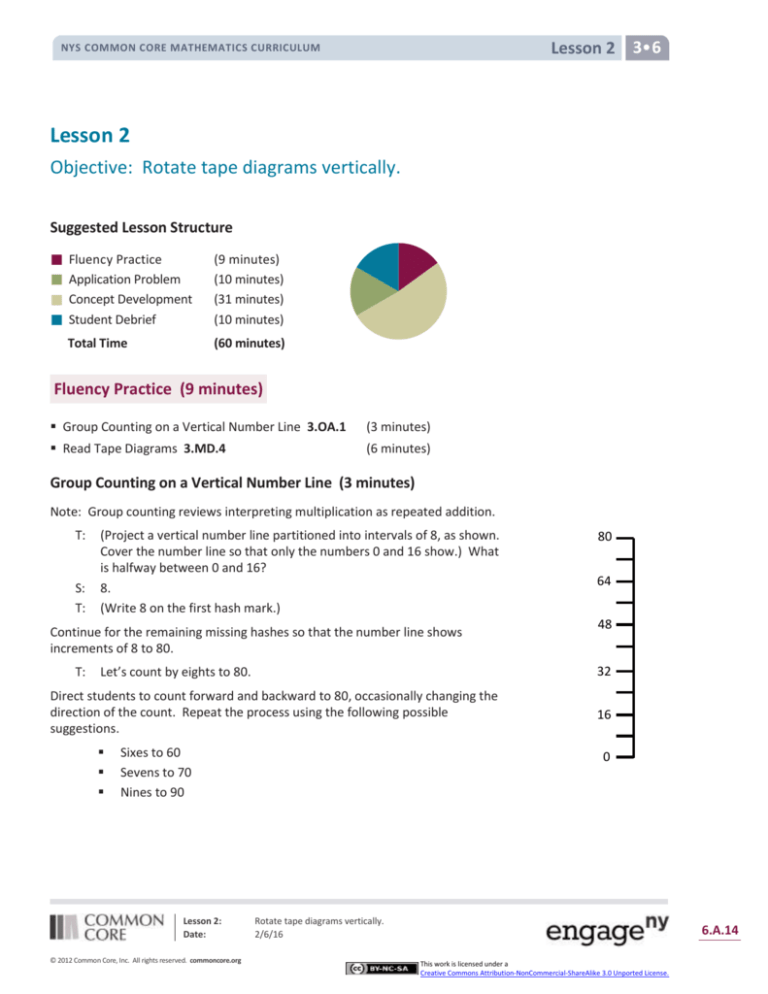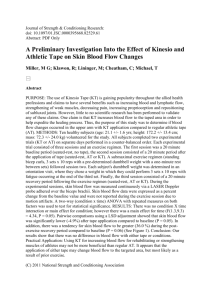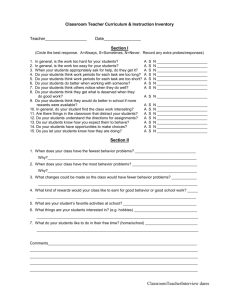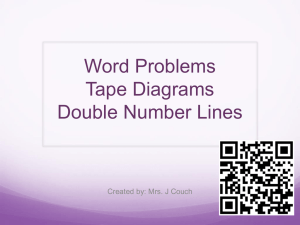
Lesson 2 3•6
NYS COMMON CORE MATHEMATICS CURRICULUM
Lesson 2
Objective: Rotate tape diagrams vertically.
Suggested Lesson Structure
Fluency Practice
Application Problem
Concept Development
Student Debrief
Total Time
(9 minutes)
(10 minutes)
(31 minutes)
(10 minutes)
(60 minutes)
Fluency Practice (9 minutes)
Group Counting on a Vertical Number Line 3.OA.1
(3 minutes)
Read Tape Diagrams 3.MD.4
(6 minutes)
Group Counting on a Vertical Number Line (3 minutes)
Note: Group counting reviews interpreting multiplication as repeated addition.
T:
S:
T:
(Project a vertical number line partitioned into intervals of 8, as shown.
Cover the number line so that only the numbers 0 and 16 show.) What
is halfway between 0 and 16?
8.
(Write 8 on the first hash mark.)
Continue for the remaining missing hashes so that the number line shows
increments of 8 to 80.
T:
Direct students to count forward and backward to 80, occasionally changing the
direction of the count. Repeat the process using the following possible
suggestions.
Sixes to 60
Sevens to 70
Nines to 90
Lesson 2:
Date:
© 2012 Common Core, Inc. All rights reserved. commoncore.org
64
48
32
Let’s count by eights to 80.
80
16
0
Rotate tape diagrams vertically.
2/6/16
6.A.14
This work is licensed under a
Creative Commons Attribution-NonCommercial-ShareAlike 3.0 Unported License.
Lesson 2 3•6
NYS COMMON CORE MATHEMATICS CURRICULUM
Read Tape Diagrams (6 minutes)
Materials: (S) Personal white boards
Note: This fluency activity reviews the relationship between the value of each unit in a tape diagram and the
total value of the tape diagram. It also reviews comparison tape diagrams in preparation for today’s lesson.
T:
S:
T:
S:
(Project a tape diagram with 7 units.) Each unit in the tape diagram has a value of 4. Write a
multiplication sentence that represents the total value of the tape diagram.
(Write 7 × 4 = 28.)
What is the total value of the tape diagram?
28!
Use the same tape diagram. Repeat the process with the following suggested values for the units: 6, 3, 9, 7,
and 8.
T:
S:
T:
S:
T:
S:
(Project tape diagrams as shown.)
A:
What is the value of each unit in tape
8
8
8
8
diagrams A and B?
4
8!
B:
8
8
8
8
8
Write a multiplication sentence that
4
represents the total value of tape
diagram A.
(Write 4 × 8 = 32.)
Write a multiplication sentence that represents the total value of tape diagram B.
(Write 7 × 8 = 56.)
8
8
Continue with the following possible questions:
What is the total value of both tape diagrams?
How many more units of 8 are in tape diagram B?
What is the total difference in the values of tape diagrams A and B?
Application Problem (10 minutes)
Reisha plays in three basketball games. She scores 12 points in Game 1, 8 points in Game 2, and 16 points in
Game 3. Each basket that she made was worth 2 points. She uses tape diagrams with a unit size of 2 to
represent the points she scored in each game. How many total units of 2 will it take to represent the points
she scored in all three games?
Lesson 2:
Date:
© 2012 Common Core, Inc. All rights reserved. commoncore.org
Rotate tape diagrams vertically.
2/6/16
6.A.15
This work is licensed under a
Creative Commons Attribution-NonCommercial-ShareAlike 3.0 Unported License.
Lesson 2 3•6
NYS COMMON CORE MATHEMATICS CURRICULUM
Note: This problem reviews building tape diagrams with a unit size larger than 1 in anticipation of students
using this same skill in the Concept Development. Ask students to solve this problem on personal white
boards so that they can easily modify their work as they use it in the Concept Development. Invite students
to discuss what the total number of units represents in relation to the three basketball games (18 total units
of 2 is equal to 18 total baskets scored).
Concept Development (31 minutes)
Materials: (S) Tape diagrams from Application Problem, personal white boards
Problem 1: Rotate tape diagrams to make vertical tape diagrams with units of 2.
T:
S:
T:
S:
T:
S:
T:
S:
T:
S:
T:
S:
T:
Turn your board so the bars on your tape
diagrams are vertical like mine. (Model.) Erase
the number of units labels, the brackets, and
the points labels. How are these vertical tape
diagrams similar to the picture graphs you
made yesterday?
They both show us data. There are labels
on both of them. Each unit on the vertical
tape diagrams represents 2 points. The
symbol in the picture graph had a value greater
than 1, and the unit in the vertical tape
diagram has a value greater than 1.
How are the vertical tape diagrams different
from the picture graphs?
The units are connected in the vertical tape diagrams. The pictures were separate in the picture
graphs. The units in the vertical tape diagrams are labeled, but in our picture graphs the value of
the unit was shown on the bottom of the graph.
Nice observations. Put your finger on the tape that shows data about Game 1. Now, write a
multiplication equation to show the value of Game 1’s tape.
(Write 6 × 2 = 12.)
What is the value of Game 1’s tape?
12 points!
How did you know that the unit is points?
The Application Problem says Reisha scores 12 points in Game 1.
Let’s write a title on our vertical tape diagrams to help others understand our data. What does the
data on the vertical tape diagrams show us?
The points Reisha scores in three basketball games.
Write Points Reisha Scores for your title. (Model appropriate placement of the title.)
Lesson 2:
Date:
© 2012 Common Core, Inc. All rights reserved. commoncore.org
Rotate tape diagrams vertically.
2/6/16
6.A.16
This work is licensed under a
Creative Commons Attribution-NonCommercial-ShareAlike 3.0 Unported License.
NYS COMMON CORE MATHEMATICS CURRICULUM
Lesson 2 3 6
Problem 2: Draw vertical tape diagrams with units of 4.
T:
S:
T:
S:
Let’s use the same data from the Application Problem
to create vertical tape diagrams where each unit has a
value of 4 points instead of 2 points. Talk to a partner.
How many units will I draw to represent Reisha’s
points in Game 1? How do you know?
Three units, because she scored 12 points in Game 1,
and 3 units of 4 points equals 12 points. Three
units, because 3 × 4 = 12. Three units, because 12 ÷
4 = 3. Three units, because the value of each unit is
now twice as much. Before we drew 6 units of 2, so
now we draw half as many units. Each new unit has
the value of two old units.
Draw the 3 units vertically and label each unit 4.
(Model.) What label do we need for this tape?
Game 1.
Continue the process for Games 2 and 3.
T:
S:
T:
S:
T:
S:
T:
S:
T:
MP.2
S:
T:
S:
How many total units of 4 does it take to represent the
points Reisha scored in all three games?
9 units!
How does this compare to the total units of 2 it took to
represent Reisha’s total points?
It takes fewer total units when we used units of 4. It
took half as many total units when we used units of 4.
Why does it take fewer units when you used units of 4?
The units are bigger. The units represent a larger
amount.
How can you use the vertical tape diagrams to write a
multiplication number sentence that represents the
total points Reisha scored in all three games?
Multiply the total number of units times the value of
each unit. We can multiply 9 times 4.
Write a multiplication number sentence to show the
total points Reisha scored in all three games.
(Write 9 × 4 = 36.)
How many points did Reisha score in all three games?
36 points!
Continue with the following possible suggestions:
How many more units of 4 did you draw for Game 1
than Game 2? How does this help you find how many
Lesson 2:
Date:
© 2012 Common Core, Inc. All rights reserved. commoncore.org
NOTE ON
MULTIPLE MEANS OF
ENGAGEMENT:
Although it is not possible to score 4
points at once in a basketball game, it
can be helpful to rearrange the data in
this way to see news things
mathematically.
NOTES ON
MULTIPLE MEANS OF
ENGAGEMENT:
Students working above grade level
and others may use parentheses and
variables in their equations that
represent the total points scored in all
three games. Celebrate all true
expressions, particularly those that
apply the distributive property.
Students working below grade level
and others may benefit from more
scaffolded instruction for constructing
and solving equations for three
addends (number of units) and the
total points.
NOTES ON
MULTIPLE MEANS OF
REPRESENTATION:
In Problem 1 of the Problem Set, some
students with perceptual challenges
may have difficulty tracking rows of
stamps as they count. Have students
place a straightedge below each row as
they count by fours. In addition,
students working below grade level
may benefit from a fluency drill that
reviews the fours skip-count.
Rotate tape diagrams vertically.
2/6/16
6.A.17
This work is licensed under a
Creative Commons Attribution-NonCommercial-ShareAlike 3.0 Unported License.
Lesson 2 3 6
NYS COMMON CORE MATHEMATICS CURRICULUM
MP.2
more points Reisha scored in Game 1 than in
Game 2?
Suppose Reisha scored 4 fewer points in Game 3.
How many units of 4 do you need to erase from
Game 3’s tape to show the new points?
Reisha scores 21 points in a fourth game. Can
you use units of 4 to represent the points Reisha
scores in Game 4 on a vertical tape diagram?
Problem Set (10 minutes)
Students should do their personal best to complete the
Problem Set within the allotted 10 minutes. For some
classes, it may be appropriate to modify the assignment by
specifying which problems they work on first. Some
problems do not specify a method for solving. Students
solve these problems using the RDW approach used for
Application Problems.
Student Debrief (10 minutes)
Lesson Objective: Rotate tape diagrams vertically.
The Student Debrief is intended to invite reflection and
active processing of the total lesson experience.
Invite students to review their solutions for the Problem
Set. They should check work by comparing answers with a
partner before going over answers as a class. Look for
misconceptions or misunderstandings that can be
addressed in the Debrief. Guide students in a conversation
to debrief the Problem Set and process the lesson.
You may choose to use any combination of the questions
below to lead the discussion.
How does multiplication help you interpret the
vertical tape diagrams on the Problem Set?
Could you display the same data in Problem 1 in a
vertical tape diagram with units of 6? Why or
why not?
If the value of the unit for your vertical tape
diagrams in Problem 2 was 2 instead of 4, how
would the number of units change? How about
for 8?
In what ways do vertical tape diagrams relate to picture graphs?
Lesson 2:
Date:
© 2012 Common Core, Inc. All rights reserved. commoncore.org
Rotate tape diagrams vertically.
2/6/16
6.A.18
This work is licensed under a
Creative Commons Attribution-NonCommercial-ShareAlike 3.0 Unported License.
Lesson 2 3 6
NYS COMMON CORE MATHEMATICS CURRICULUM
How did today’s Application Problem relate to our new learning?
In what ways did the fluency activities prepare you for today’s lesson?
Exit Ticket (3 minutes)
After the Student Debrief, instruct students to complete the Exit Ticket. A review of their work will help you
assess the students’ understanding of the concepts that were presented in the lesson today and plan more
effectively for future lessons. You may read the questions aloud to the students.
Lesson 2:
Date:
© 2012 Common Core, Inc. All rights reserved. commoncore.org
Rotate tape diagrams vertically.
2/6/16
6.A.19
This work is licensed under a
Creative Commons Attribution-NonCommercial-ShareAlike 3.0 Unported License.
Lesson 2 Problem Set 3 6
NYS COMMON CORE MATHEMATICS CURRICULUM
Name
Date
1. Find the total number of stamps each student has. Draw tape diagrams with a unit size of 4 to show the
number of stamps each student has. The first one has been done for you.
Tanisha
Each
represents 1 stamp.
Dana
Raquel
Anna
Dana:
4
4
4
4
Tanisha:
Raquel:
Anna:
2. Explain how you can create a vertical tape diagram to show this data.
Lesson 2:
Date:
© 2012 Common Core, Inc. All rights reserved. commoncore.org
Rotate tape diagrams vertically.
2/6/16
6.A.20
This work is licensed under a
Creative Commons Attribution-NonCommercial-ShareAlike 3.0 Unported License.
Lesson 2 Problem Set 3 6
NYS COMMON CORE MATHEMATICS CURRICULUM
3. Complete the vertical tape diagrams below using the data from Problem 1.
a.
b.
4
4
4
8
4
8
Dana
Tanisha
Raquel
Anna
Dana
Tanisha
Raquel
Anna
c. What is a good title for the vertical tape diagrams?
d. How many total units of 4 are in the vertical tape diagram in Problem 3(a)?
e. How many total units of 8 are in the vertical tape diagram in Problem 3(b)?
f.
Compare your answers to Parts (d) and (e). Why does the number of units change?
g. Mattaeus looks at the vertical tape diagram in 3(b) and finds the total number of Anna and
Raquel’s stamps by writing the equation, 7 × 8 = 56. Explain his thinking.
Lesson 2:
Date:
© 2012 Common Core, Inc. All rights reserved. commoncore.org
Rotate tape diagrams vertically.
2/6/16
6.A.21
This work is licensed under a
Creative Commons Attribution-NonCommercial-ShareAlike 3.0 Unported License.
Lesson 2 Exit Ticket 3 6
NYS COMMON CORE MATHEMATICS CURRICULUM
Name
Date
1. The chart below shows a survey of the book club’s favorite type of books.
Book Club’s Favorite Type of Books
Type of Book
Number of Votes
Mystery
12
Biography
16
Fantasy
20
Science Fiction
8
a. Draw tape diagrams with a unit size of 4 to represent the book club’s favorite type of books.
b. Use your tape diagrams to draw vertical tape diagrams that represent the data.
Lesson 2:
Date:
© 2012 Common Core, Inc. All rights reserved. commoncore.org
Rotate tape diagrams vertically.
2/6/16
6.A.22
This work is licensed under a
Creative Commons Attribution-NonCommercial-ShareAlike 3.0 Unported License.
Lesson 2 Homework 3 6
NYS COMMON CORE MATHEMATICS CURRICULUM
Name
Date
1. Adi surveys third-graders to find out what their favorite fruits are. The results are in the table below.
Favorite Fruits of Third-Graders
Fruit
Number of Student Votes
Banana
8
Apple
16
Strawberry
12
Peach
4
Draw units of 2 to complete the tape diagrams to show the total votes for each fruit. The first one has
been done for you.
Banana:
2
2
2
2
Apple:
Strawberry:
Peach:
2. Explain how you can create a vertical tape diagram to show this data.
Lesson 2:
Date:
© 2012 Common Core, Inc. All rights reserved. commoncore.org
Rotate tape diagrams vertically.
2/6/16
6.A.23
This work is licensed under a
Creative Commons Attribution-NonCommercial-ShareAlike 3.0 Unported License.
Lesson 2 Homework 3 6
NYS COMMON CORE MATHEMATICS CURRICULUM
3. Complete the vertical tape diagrams below using the data from Problem 1.
a.
b.
2
2
2
4
2
4
Banana
Apple
Strawberry
Peach
Banana
Apple
Strawberry
Peach
c. What is a good title for the vertical tape diagrams?
d. Compare the number of units used in each vertical tape diagram. Why does the number of units
change?
e. Write a multiplication number sentence to show the total number of votes for strawberry in the
vertical tape diagram in Problem 3(a).
f.
Write a multiplication number sentence to show the total number of votes for strawberry in the
vertical tape diagram in Problem 3(b).
g. What changes in your multiplication number sentences in (e) and (f)? Why?
Lesson 2:
Date:
© 2012 Common Core, Inc. All rights reserved. commoncore.org
Rotate tape diagrams vertically.
2/6/16
6.A.24
This work is licensed under a
Creative Commons Attribution-NonCommercial-ShareAlike 3.0 Unported License.










